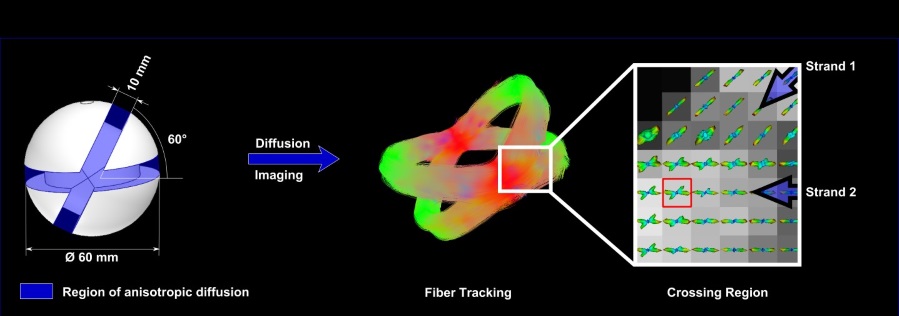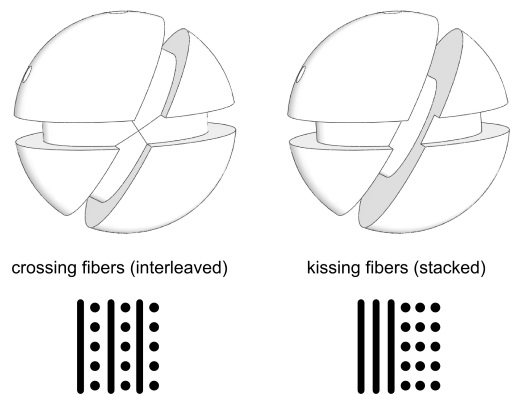Q-Ball Crossing Phantom
The Q-Ball phantom [1] consists of two several fiber strands formed by polyester fibers wound onto a spherical spindle. Between the fibers, the diffusing aqueous solution is located. In the two crossing points, the two fiber strands are either wound on top of each other, or they are interleaved by many changes of the winding direction (see figure below). This way, the restricted diffusion in fiber crossing in white matter of the brain can be modeled.
This renders the Q-ball crossing phantom, for example, an important tool for verification of the correct resolution of fiber crossings in fiber tracking algorithms.

Standard Version
Technical specifications
- Cylindrical phantom container: Diameter: 150 mm, High: 150 mm
- Two crossing fiber strands with high fractional anisotropy (FA = 0.8)
- Outer Diameter of the spindle / fiber strands: 60 mm
- Two options:
1. Interleaved fiber strands: During production, the two fiber strands are interleaved by alternating winding into the cutouts.
2. Stacked fiber strand: the fiber strands are wound after each other into the cutouts yielding so that they touch each other. - Crossing angle: 45°, 60° or 90°
Customer-specific modifications
- Crossing angles
- Size of the spindle
- Size of the phantom container
- Cross-sections of the fiber strands
- FA (coming soon)
Application examples
![]() Ground truth for validation of advanced diffusion imaging sequences and post-processing methods (Q-ball, high angular resolution diffusion imaging (HARDI), diffusion kurtosis tensor reconstruction)
Ground truth for validation of advanced diffusion imaging sequences and post-processing methods (Q-ball, high angular resolution diffusion imaging (HARDI), diffusion kurtosis tensor reconstruction)
![]() Testing of fiber tracking algorithms in crossing regions
Testing of fiber tracking algorithms in crossing regions
![]() Validation of quantitative parameters obtained from DTI measurements, such as fractional anisotropy (FA), generalized fractional anisotropy (GFA) [2]
Validation of quantitative parameters obtained from DTI measurements, such as fractional anisotropy (FA), generalized fractional anisotropy (GFA) [2]
![]() Validation of compressed sensing techniques [3]
Validation of compressed sensing techniques [3]
![]() Quality assurance in clinical studies
Quality assurance in clinical studies

User reference
References: scientific articles
Novel spherical phantoms for Q-ball imaging under in vivo conditions.
Opportunities and pitfalls in the quantification of fiber integrity: what can we gain from Q-ball imaging?
Multi-shell diffusion signal recovery from sparse measurements.
Sparse Reconstruction Challenge for diffusion MRI: Validation on a physical phantom to determine which acquisition scheme and analysis method to use?
